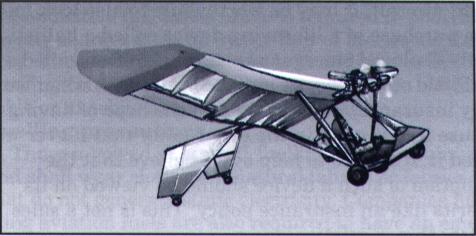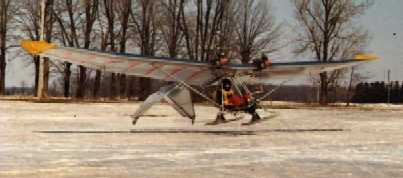Lazair Crash in Aviation Safety Letter from Transport Canada. 02.2004 issue not on their web yet.
A Stall at Pattern Altitude Claims Another LifeThe pilot of a Lazair ultralight aircraft had taken off to practice touch and go. He was proceeding on a wide left-hand circuit downwind for landing. He had been sequenced number one and as he turned base, witnesses heard both engines stop. The aircraft continued on what looked like a power-off glide back to the airport. The Lazair ultralight aircraft is equipped with two small 185 cc Rotax engines mounted forward of the leading edge of the wing, and the pilot sits underneath the wing. As the aircraft approached final, the wings were seen to rock from side to side. The aircraft then nosed over to about a 90° angle and the pilot was unable to recover from the dive, even though the altitude from which it was begun was reported to be close to 500 ft. The pilot lost his life. Each year stalls account for a high number of mishaps and many deaths. They often occur in the pattern, after takeoff or when coming in for landing. Flying low and tight circles over a friend's house has also claimed the lives of many pilots. Stalls are often related to a sudden engine failure, poor take-off or landing techniques, and the failure to recognize the onset of a stall. A review of the theory of flight and the stalling characteristics of your airplane with an experienced instructor should help you stay out of trouble, especially if you train regularly. No one is immune to the danger of a stall, as it claims lives indiscriminately. Stalls can be prevented. The warning sign is usually an unmistakable buffet or shaking of the airplane. The buffeting is the result of the airflow separating from the top of the wing. It can occur very quickly depending on the angle of attack, angle of bank and the gross weight of the aircraft. It needs your immediate attention. To recover from the stall, reduce the angle of attack by gently lowering the nose of the airplane with the elevator control. Once the angle of attack is less than its critical angle, the air molecules will flow smoothly over the top of the wing again and the production of lift will resume. It's as easy as that. Remember that you must apply all available power to accelerate the airplane and  attack is usually close to 18°. When you are flying at or close to this angle, the air molecules racing over the top of the wing cannot provide a uniform, highvelocity, laminated airflow, and the wing stalls. Remember that at the moment the wing stops flying, it creates stress in your mind and you may have a tendency to do the opposite of that which is required to regain lift. As the airplane pitches nose down, many will have the instinct to pull back on the elevator control. Don't. Release back pressure on the controls and apply power. You must realize that airplanes can be stalled at any altitude or at any airspeed. It will occur when an airplane exceeds its critical angle of attack, independent of attitude and airspeed. In most cases, there are five warning signs. 1- The unmistakable buffet or shaking that is usually felt in the airplane and on the flight controls. 2- Flight control response diminishes when the airplane approaches the stall. Controls may feel mushy and less effective. 3- The airspeed indicator approaches the beginning of the white or green arc. 4- A distinctive difference in sound occurs as wind noise diminishes considerably. 5- A stall warning horn will be heard (if the aircraft is equipped with one). There is a sixth sign that will be felt depending on your perception of subtle differences in your weight against the seat cushion; this is a certain weightlessness as you gravitate upward while the aircraft wants to proceed downward. As a pilot, you owe it to yourself to practice stalls and to be able to recognize the conditions that lead to them. This is a very brief review and I leave you with this thought--the airplane will always stall when the wings exceed their critical angle of attack. Keep those wings flying . |
Excellent Lazair Ultralight Websites
Lazair.com Lazair Forum Lazair Forum on Yahoo LAZAIRFORCE ulflyer News Letter Ultralightnews Smithsonian Freedom Airtec Bob Comperini Toronto Museum UltraFlight Spinners Fatal Accident Fiberglass Tips Dale Kramer 25Years Thirty Thousand Feet - Aviation Directory


